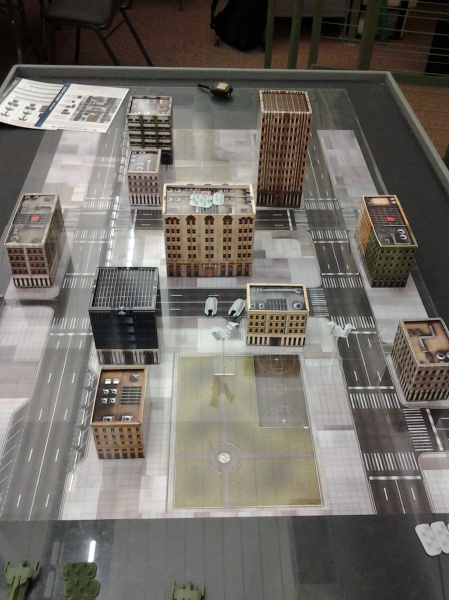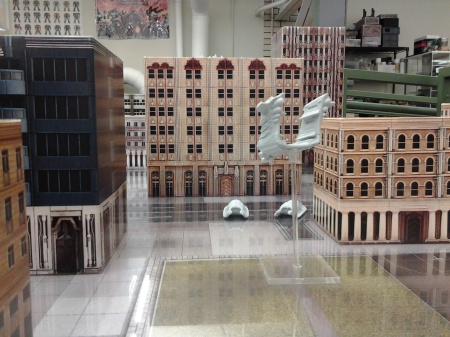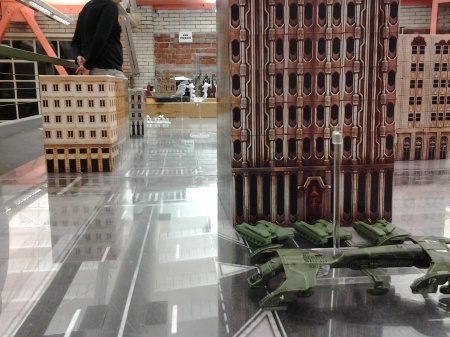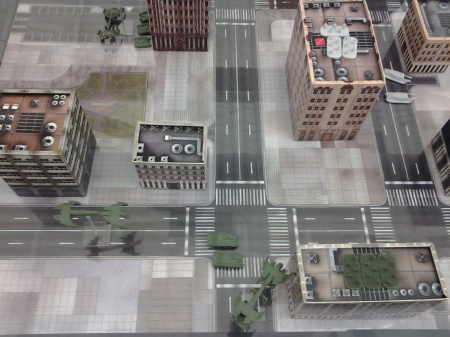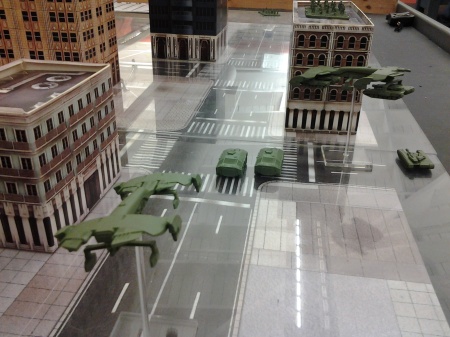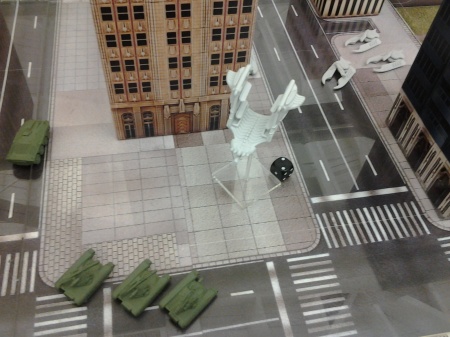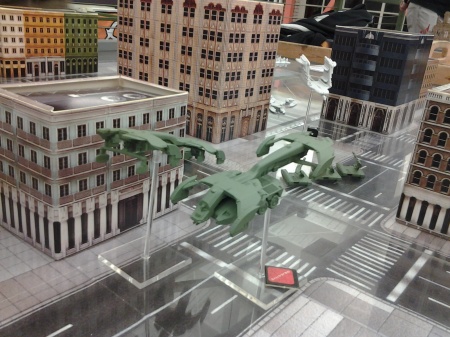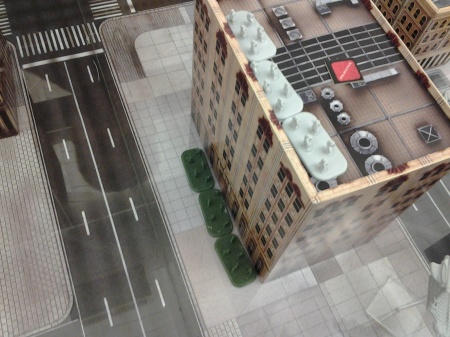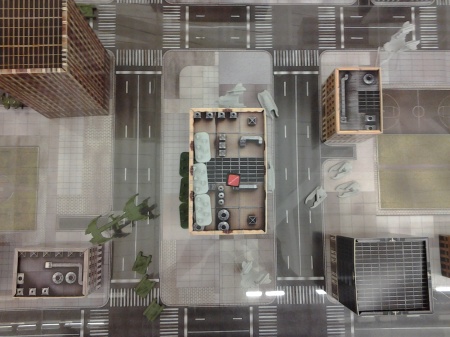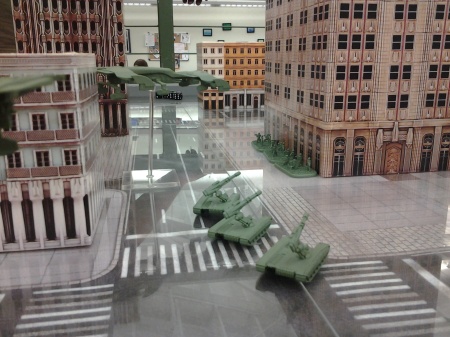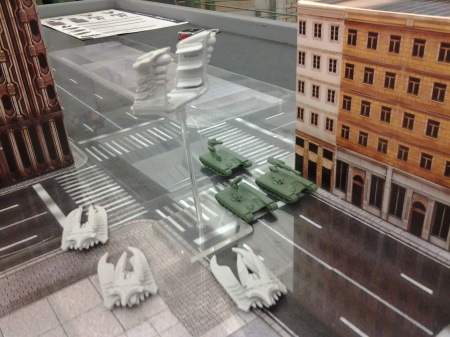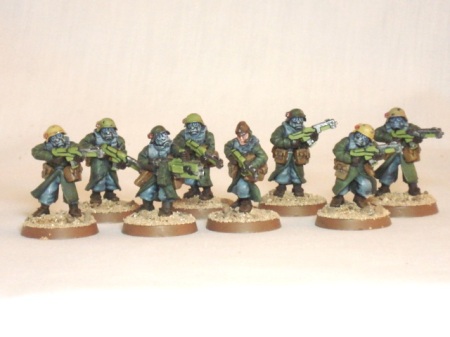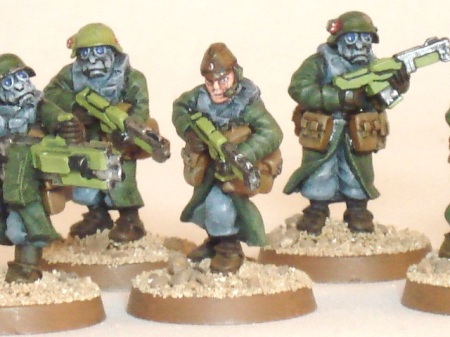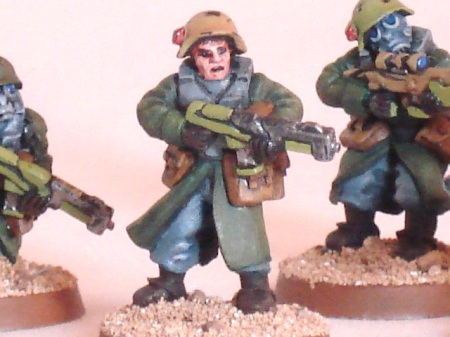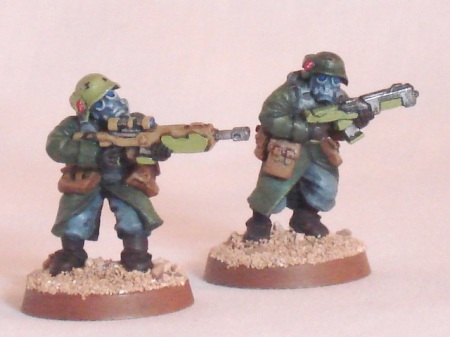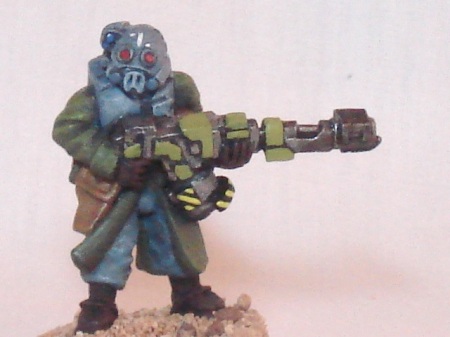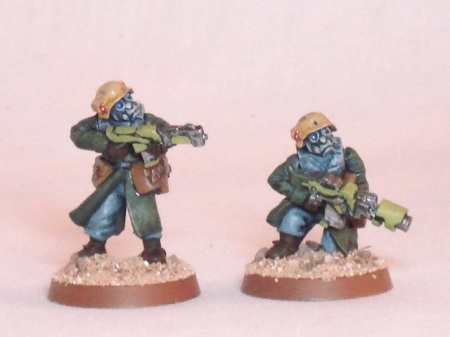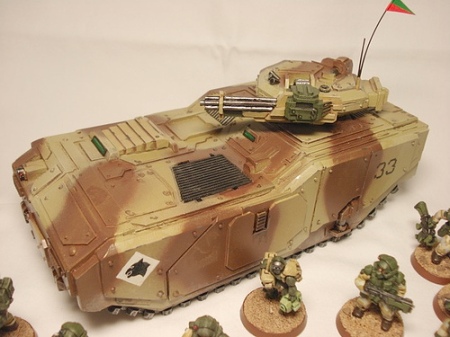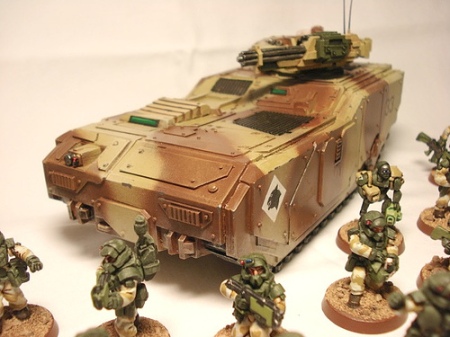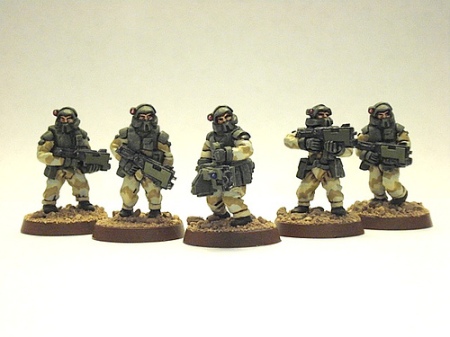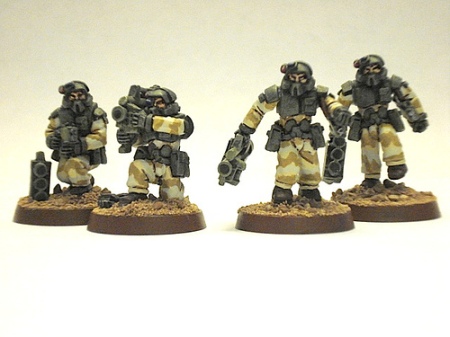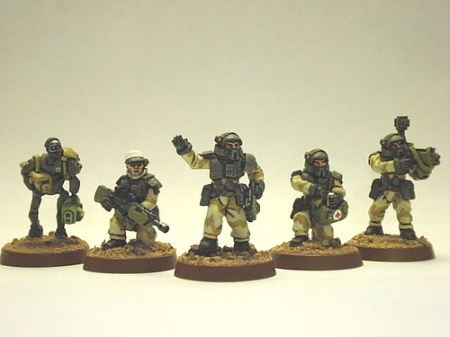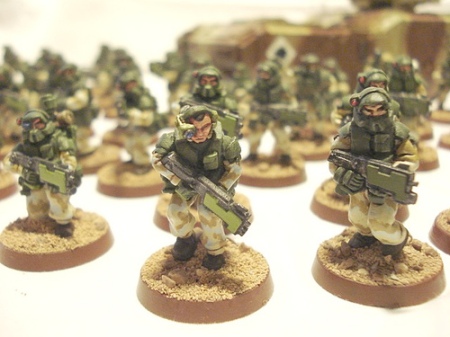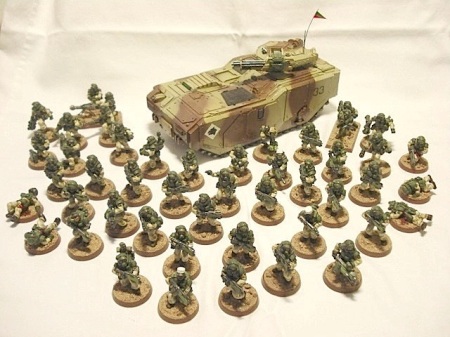Dropzone Commander is, in a word, fun! The Dropzone was commanded!
(Scroll down for pics)
I got my first game in last night with Ian Chadwick. We used the models in the starter set – I played UCM and Ian took the Scourge. DZC was exactly what I was hoping for in a sci-fi minis game; it was dynamic, fast-paced and engaging.
First of all, it looks awesome all set up! The cityscape that comes with the starter set is an inspired bit of design. You get two poster maps, which are different and these fit together to form a grid of city streets. On top of this, you set up 10 card building that are also included. They fold out and are ready to go in no time at all. I usually don’t play without fully painted minis but Ian and I were so hot to try this game we just put them together and went for it. I did manage to get a coat of color primer on them and painted one dropship but even without paint, they looked awesome on the board! When we have our armies fully painted this game is just going to be brilliant! As a longtime Epic Space Marine fan, the larger scale is very appealing to me. You definitely get a greater sense of looking at an entire battlefield, of being in command of an entire operation instead of a smaller tactical engagement.
Any wargame that even attempts to predict the battlefield of the future needs to take the effect of technology on combat doctrine into account. Games like 40K are simply WW2 with lasers. Even Stargrunt (which I still love) is really Vietnam in space. DZC may not hit all the buttons but it certainly feels like it’s hitting a lot of them.
First off, all armies are entirely airmobile, or at least highly mobile (one race, the Shaltari, teleport around the battlefield). This means that the battlefield is a constantly changing environment as units can rapidly redeploy where needed and the game mechanics reflect this. For example, a UCM APC can move 4″ which isn’t horrible but a dropship can pick it up and move it up to 9″ in one turn. Since all units can do this, it means that simply driving forward on the ground is more of a last resort – you only really do it unless your dropships are gone. In the game we played, the APCs drove on the ground the last few inches to their objectives after disembarking from their dropships (which then pulled back into cover somewhere, waiting on station for the call for dustoff).
Many minis games I have played feel very static compared to DZC. Even mobile armies in 40K don’t move like DZC units do (of course the different scales make a difference here). In DZC, if you find that things are happening somewhere else on the battlefield, you really can redeploy all the way across the map in very short order. Early in our game, I flew in with an infantry unit, occupied and objective building on T1, located the objective on T2, then re-embarked and got it off the map! Granted I was lucky on the search roll, but man it was fast!
After that it looked like things were developing on the opposite side of the map, so I started picking up units and flying them over that way. Later, when I found my heavy tanks a bit out of position, again I picked them up and flew them where they needed to be. The ground units did drive around some of course, but when they needed to cover longer distance, they could call in the dropships to pick them up.
So, the game makes the dropships and transports extremely important. Lose your mobility and your chances of success drop rapidly. Late game, one of Ian’s APCs was hauling ass for the board edge with an objective. The only units I had in range that could stop him were my AA tanks, which are fortunately also effective against ground units (unlike Scourge AA tanks). I took out his APC, but his infantry survived (luckily for him). I wasn’t able to stop him from scoring for holding that objective, but there was no way he was getting off the board with those infantry, which wound up diving into a building to hide until game end.
The dynamic game play also means that the momentum and initiative can shift rapidly. I had the lead early on, but Ian was in position to score late game. As unit attrition wore me down, it became clear that Ian was set up for an end run, which he managed to pull off for the win (barely – had I killed his infantry in the destroyed APC, we would have been tied on objectives). The sequence of play uses alternate unit activation, which I vastly prefer over Igo-Ugo systems. Since you roll for initiative every turn, this has a big effect on tactics and your choice of what units to move and when. It also means you’re never sitting around waiting for your turn for very long.
Many weapons have infinite range (basically LOS) unless firing at a unit with active countermeasures, which brings the ranges down to 36″ or (much) less. This feels right as a railgun or laser should have no trouble engaging something it can see. Infantry in the open are thus extremely vulnerable as they have no countermeasures (usually). The best they can hope for is to be ignored. But since they are the only units capable of entering buildings where the objectives often are, they’re priority targets. On foot, they only have a 2″ move. Once they’re inside a building, it’s often better to try and take the building down to kill the infantry (though some buildings are quite tough).
This brings another element of the game into play – CQB (Close Quarters Battle). Infantry vs infantry fights usually are going to happen inside a building, and the game makes this go very quickly. One side or the other will be wiped out or broken in one round. My dice crapped out me (rolling only 3 hits on 12 dice needing 4+ – I rolled 5 1’s and the rest 2’s and 3’s!) and Ian’s Scourge warriors killed two squads and broke the other one. Despite that, I like this – the image of two opposing platoons fighting like vicious rats inside a building captures the tension and terror of CQB quite well.
So, all that put together made for a very fun game. Even though we were stopping often to look things up, I can see that once we have the rules down, this will go much much faster. Understanding how units embark and disembark their transports, the way units move and the possibilities that opens up is the key to DZC.
On top of all that, the story and background is also cool. It has shades of Mass Effect and Babylon 5 running throughout. I like the idea that although humanity lost the Earth, it has recovered and is now launching a massive counteroffensive to take it back. In that regard it is a universe where there is still hope, as opposed to the relentless grimdark of other game worlds. There is also room for more new races in the future, beyond the four already in the game. I understand the Hawk Wargames is working on a rebel army list, allowing you to play the stay-behind survivors of the Scourge invasion, and these guys roll out in these awesome looking Mad Max style trucks and whatnot. The aliens are well thought out too, and the armies really do play quite differently.
To sum up, I’m super happy with the DZC starter set! You get a ton of great stuff for about $100. Just go check it out on the Hawk Wargames website. Ian and I are already looking forward to picking up some of the other units and expanding our armies!
Pics below!
